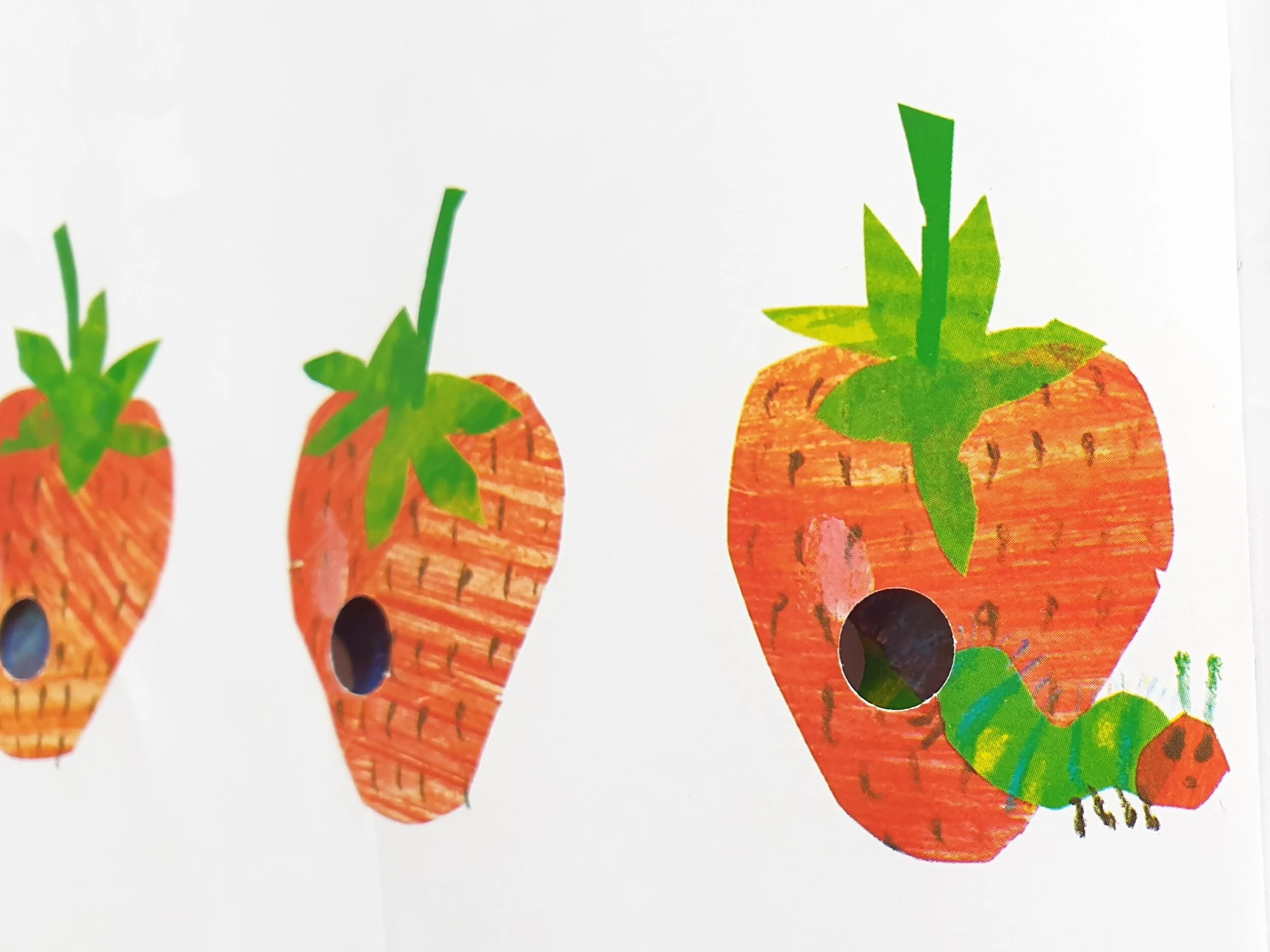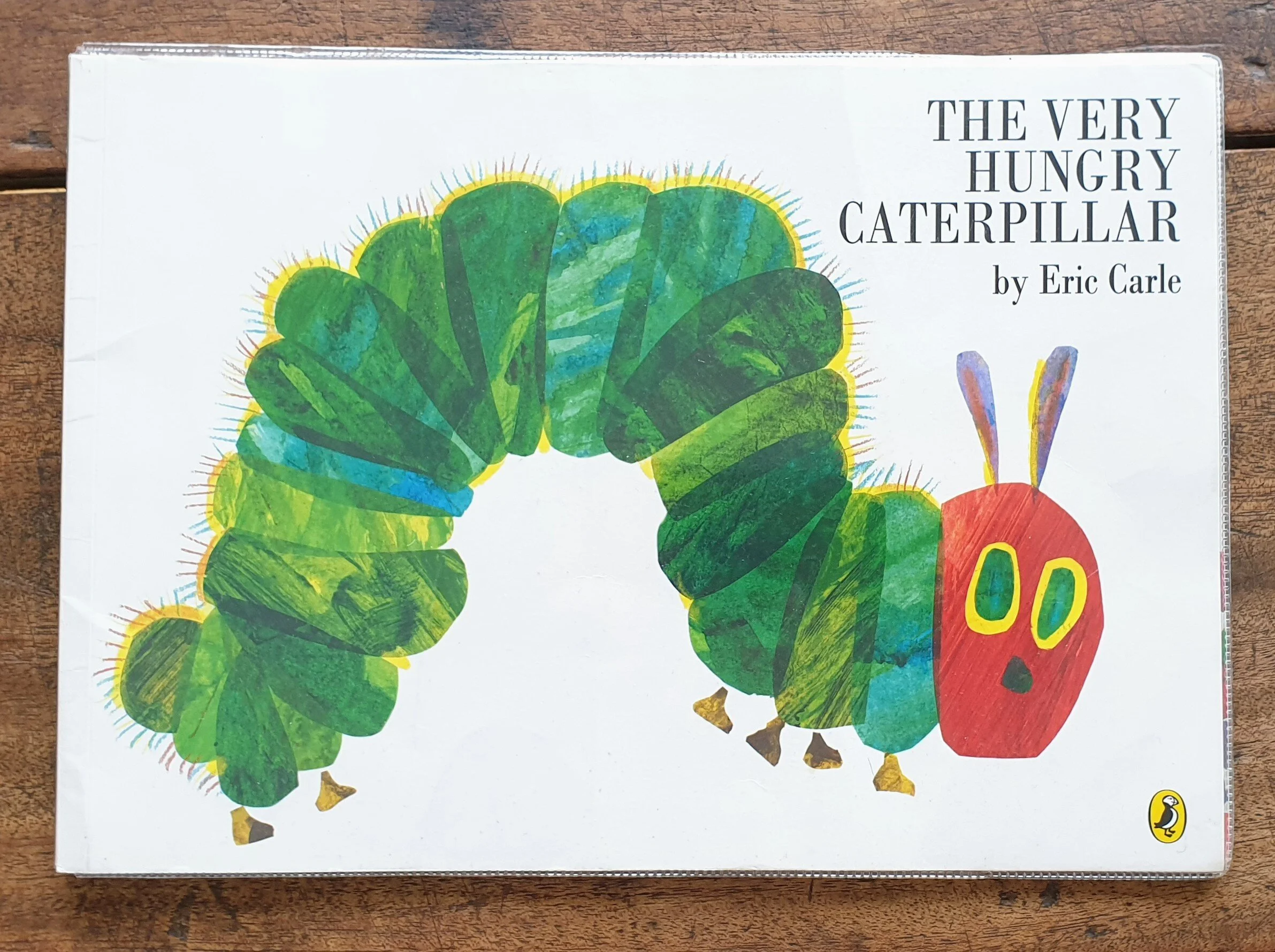Why The Very Hungry Caterpillar is a classic
From The Very Hungry Caterpillar by Eric Carle (The World Publishing Company, 1969) | © 1969 by Eric Carle
“George Bush named Eric Carle’s The Very Hungry Caterpillar as his favourite childhood book although, to many observers’ delight, it wasn’t published until he was twenty three…”
The world of children’s publishing recently lost a titan - Mr Eric Carle.
Creator of over 70 picture books, including one of the most recognisable and iconic children’s characters - a tiny and ravenous caterpillar.
The Very Hungry Caterpillar by Eric Carle (Puffin Books) is a classic - and Carle’s best-known work. Fortunately for me, it was first published in 1969 - meaning I got to enjoy it myself as a kid. The Very Hungry Caterpillar is seared into our collective childhood memories, and (according to the publisher) a copy of it is sold somewhere in the world every 30 seconds!
Carle’s combination of simple language and imagery lends the otherwise benign beginning a magical feeling:
In the light of the moon a little egg lay on a leaf.
From The Very Hungry Caterpillar by Eric Carle (The World Publishing Company, 1969) | © 1969 by Eric Carle
Seeing that opening spread takes me straight back to storytime at nursery school.
The moon has a smiling, friendly face - as does the sun on the next page, whose warmth causes the egg to hatch and -
Pop! - Out of the egg came a tiny and very hungry caterpillar.
Hand-painted tissue papers form the basis of Carle’s joyful collage illustrations. Bold and childlike, they reflect the influence of modern artists like Picasso and Matisse (and hark back to Carle’s experience as art director of a New York advertising agency).
The Very Hungry Caterpillar began life as an idea about a week in the life of a bookworm which Carle had while using a hole punch on a pile of papers at his desk. His editor suggested a caterpillar rather than a worm, Carle shouted “Butterfly!” - and a literary classic was conceived.
Even today, The Very Hungry Caterpillar feels unique. As Lucy Mangan writes in her memoir of childhood reading:
‘What entranced me, and millions of other readers since it was published in 1969, was the fact that it was so different from them. The caterpillar had eaten little holes through all the pages for a start. And the pages were all different sizes. Some were narrow enough to make turning them a fiddly business, some large enough to make them flappily unwieldy in tiny hand, and some were just right.’
- Bookworm - A Memoir of Childhood Reading by Lucy Mangan
Ah, yes - those die cut holes that punctuate the pages! I remember poking my fingers through them at nursery school (and the public library), then turning the page to watch them wiggle (alongside the emerging caterpillar) on the other side. “It’s a book you can play with, a toy you can read,” explained Carle. Many years later, I played the same game with my own kids - snuggled up on my lap, a felt tip caterpillar face drawn on their fingertips.
Our insatiable caterpillar friend munches his way through a new kind of choice fruit - starting with one apple on Monday, through to five oranges on Friday.
From The Very Hungry Caterpillar by Eric Carle (The World Publishing Company, 1969) | © 1969 by Eric Carle
It’s a healthy start - ‘[B]ut he was still hungry.’
With each passing day, the pieces of fruit that Caterpillar eats grows incrementally in number. So through repeated readings, children are subtly taught days of the week AND practice their counting.
Saturday’s spread is iconic - a visual smorgasbord of choice American culinary classics, including chocolate cake, ice cream, salami, cherry pie and an exotic slice of watermelon.
From The Very Hungry Caterpillar by Eric Carle (The World Publishing Company, 1969) | © 1969 by Eric Carle
But Caterpillar’s junk food binge has consequences: That night, he suffers from stomach ache. (And grows very fat indeed!)
From a tiny (and very hungry) caterpillar to a giant, fat caterpillar who fills the page and looks fit to burst! He then builds ‘a small house, called a cocoon, around himself’, before finally completing his metamorphosis into a beautiful butterfly!
From The Very Hungry Caterpillar by Eric Carle (The World Publishing Company, 1969) | © 1969 by Eric Carle
The Atlantic article, How The Very Hungry Caterpillar Became a Classic summarises the story thus:
[A] caterpillar hatches out of an egg on a Sunday, proceeds to eat vibrantly colored fruits it finds in escalating quantities from Monday to Friday, goes on a junk-food-eating rampage on Saturday, eats a nice green leaf on Sunday, and then nestles into a cocoon for two weeks and emerges a beautiful butterfly[.]
- The Atlantic
But why did the butterfly come from a cocoon, rather than a chrysalis? On his website, Carle gives what he describes as his ‘unscientific explanation’:
My caterpillar is very unusual. As you know caterpillars don’t eat lollipops and ice cream, so you won’t find my caterpillar in any field guides. But also, when I was a small boy, my father would say, “Eric, come out of your cocoon.” He meant I should open up and be receptive to the world around me. For me, it would not sound right to say, “Come out of your chrysalis.” And so poetry won over science!
- Eric Carle
In a 2019 interview celebrating the 50th anniversary of The Very Hungry Caterpillar, Eric Carle shared his thoughts on the book’s ongoing popularity:
“I believe most children can identify with the helpless, small, insignificant caterpillar, and they rejoice with it when it turns into a beautiful butterfly. It is an affirmation to all children. It says: I too can grow up. I, too, can unfold my wings and fly into the world. I think it’s this message of hope.”
Perhaps Carle’s most significant legacy is not the books themselves but rather the effect that the shared reading of them has had on so many children. In my favourite quote from him, Carle said:
“I feel strongly that by reading with your child, by the simple act of holding them close while you read to them, you let them know that you care for them, have time for them and love them.”
His comment neatly summarises the main reason why I write this blog: To help connect you with your kids through stories worth sharing. Because the days when your children are small are precious and fleeting. So make the most of them before they spread their wings and fly into the world.
STORIES WORTH SHARING: The Very Hungry Caterpillar by Eric Carle
Good to Read because:
Children find Carle’s use of bright colours and techniques such as finger painting and paper cutouts inspiring and affirming.
It teaches lessons in counting, the days of the week, the process of metamorphosis, and the importance of choosing foods wisely!
Your kids will find the finger-sized holes irresistible! “It’s a book you can play with, a toy you can read.”
GOOD TO READ
Picture books about feeling hungry
The Crunching Munching Caterpillar by Sheridan Caine and Jack Tickle
Oh No, George! by Chris Haughton
The Gruffalo by Julia Donaldson and Axel Scheffler
The Little Mouse, The Red Ripe Strawberry and THE BIG HUNGRY BEAR by Don and Audrey Wood
BUY THE BOOK
Powered by Bookshop.org
Supporting independent bookshops
From The Very Hungry Caterpillar by Eric Carle (The World Publishing Company, 1969) | © 1969 by Eric Carle
‘The very hungry caterpillar literally eats his way through the pages of the book—and right into your child’s heart…’-
- Mother’s Manual
‘Kids ... delight in turning the flaps and poking their fingers through the holes the ever-munching caterpillar has left behind.’






